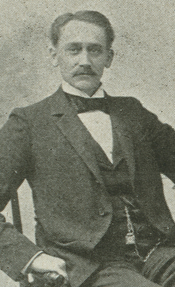John B. Corliss
John B. Corliss was a member of Congress and electric railroad promoter.
Youth and Personal life
John Blaisdell Corliss was born on June 7, 1851, in Richford, Vt. He was schooled at the Fairfax Preparatory School. In 1871, he received his B.A. from Vermont Methodist University at Montpelier. Thereafter he enrolled in the Law Department of Columbian College, Washington D.C., graduating in 1875.
Corliss married Nancy Elizabeth Danforth (daughter of William Cullen Danforth, county judge) of Barnard, Vt.[1]
He was a mason.[2] He was a member and director of the Michigan Club.
Politics
After graduation, Corliss moved to Detroit, Michigan, passed the bar and started a law practice. Within seven years he was appointed the city attorney of Detroit, which he held until 1886. Among his accomplishments as city attorney was the writing of the city's first complete charter which was passed by the Michigan Legislature in 1884.
At the state Republican convention in 1892, Corliss nominated Hazen S. Pingree for governor. Pingree was overwhelmingly defeated by John T. Rich.[3]
In 1893, he argued in favor of a Michigan woman's suffrage law before the Michigan Supreme Court.[4] The next year he was elected to Congress from Michigan's first district (Detroit). He served served four terms (until 1903). While in Congress, he chaired the Committee on Election of President, Vice President, and Representatives.
His political positions in Congress were both progressive and reactive. For instance, he sponsored a bill in 1897 for a Constitutional Amendment for the direct election of U.S. Senators. It did not pass then.[5] In his reactive side, he opposed liberal immigration laws, proposing an amendment to the immigration act that would bar foreign temporary workers from entering the U.S.[6] He supported the acquisition of the Panama Canal zone and the construction of the Canal.[7]
He was defeated for re-election in the 1902 election, whereupon he returned to his law practice in Detroit. By 1920, he was elected to the Executive Committee of the American Bar Association.[8]
Railways
In 1889, Corliss along with A. R. McLaughlin contracted to construct the Ann Arbor Street Railway. The line was operating by September 30, 1890. They were apparently just the construction contractors, as they sold the company to Henry P. Glover and H. T. Morton on January 30, 1891.[9]
Corliss was also the principal investor in the Jackson Street Railway in Jackson, Michigan. The JSR went bankrupt in 1897 and was sold at auction in September 1900.
Death
He died in Detroit on December 24, 1929 and is interred in Woodlawn Cemetery.
Notes
- ↑ Grenville M. Dodge and William Arba Ellis, Norwich University, 1819-1911: Her History, Her Graduates, Her Roll of Honor, vol. 3 (The Capitol City Press, 1911), 638.
- ↑ Albert Clark Stevens, ed., The Cyclopædia of Fraternities, 2d ed. (New York: E. B. Treat & Co., 1907), 65.
- ↑ Kalamazoo Gazette, July 29, 1892, p. 10.
- ↑ Susan B. Anthony and Ida Husted Harper, eds., The History of Woman Suffrage, vol. 4: 1883-1900 (New York: by the author, 1902), 765.
- ↑ Kalamazoo Gazette-News, June 21, 1901, p. 3.
- ↑ Asher Crosby Hinds, Hinds' Precedents of the House of Representatives of the United States, vol. 5, (Washington: G.P.O., 1907), p. 455.
- ↑ Marion Mills Miller, Great Debates in American History: From the Debates in the British Parliament on the Colonial Stamp Act (1764-1765) to the Debates in Congress at the Close of the Taft Administration (1912-1913), Volume 3: Foreign relations, part 2 (Current Literature Pub. Co., 1913), 368.
- ↑ American Bar Association Journal 6 (1920), 130.
- ↑ Samuel W. Beakes, Past and Present of Washtenaw County (Chicago: S. J. Clark Publishing Co., 1906), 713-714.
